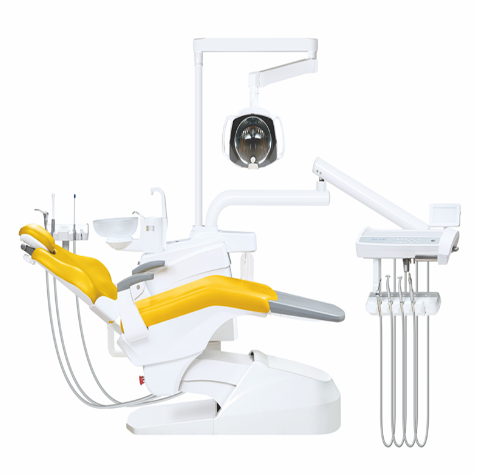What Are the Advantages of Using Dental Unit with Compressor?
In modern dentistry, there is not enough to apply dental surgeries with a simple dental chair. To make the surgery perfect, the dentist should have a full series of dental equipment such as a dental handpiece, led curing light, and other dental products. The dental chair compressor plays a very important role in the dental surgery.
Then, in this post, the author will give a full introduction to dental chair compressors.
Then, in this post, the author will give a full introduction to dental chair compressors.
What is A Dental Chair Compressor?
A dental chair compressor is an essential component of a dental office's equipment. It is a device that provides a source of compressed air for various dental procedures and tools used by dentists and dental hygienists. The compressor generates and stores pressurized air that is then distributed to various dental instruments, such as air-driven handpieces, syringes, and dental suction devices.
How Does A Dental Air Compressor Work?
A dental air compressor is a critical component in a dental office, providing a source of compressed air for various dental instruments and procedures. Here's a basic overview of how a dental air compressor works:
●Air Intake
The process begins with the intake of atmospheric air. The compressor typically has an air filter to remove dust and contaminants from the incoming air, ensuring that the air supplied to the dental instruments is clean.
●Compression
The dental air compressor features a motor-driven mechanism, which can be either a piston-type or a rotary screw-type compressor. In both cases, the goal is to compress the incoming air to a higher pressure. The compressor's mechanism operates to reduce the volume of the air while increasing its pressure.
●Piston-Type Compressor
In a piston-type compressor, a piston moves up and down within a cylinder. During the downstroke, air is drawn into the cylinder, and during the upstroke, the air is compressed.
●Rotary Screw Compressor
A rotary screw compressor employs a pair of interlocking helical rotors to compress the air. As the rotors turn, they trap and compress the air between them.
●Air Storage
The compressed air is then stored in a reservoir tank, which serves as a buffer to maintain a consistent supply of compressed air. The tank helps regulate pressure and provides a reserve of air for peak demand periods.
●Pressure Regulation
The dental air compressor is equipped with pressure regulation mechanisms to control the output pressure. Dental instruments require specific air pressure levels for various procedures, and this can be adjusted as needed.
●Filtration
Before the compressed air is delivered to dental instruments, it goes through filtration systems to remove moisture and any remaining contaminants. This filtration is crucial to ensure that the air used in dental procedures is clean and free from impurities.
●Distribution
The clean and pressurized air is then distributed to various dental instruments and equipment through a network of hoses and tubing. Dental chairs, handpieces, air-water syringes, and other tools are connected to the air supply.
●Control
Dental professionals can control the flow of compressed air to dental instruments using control valves and switches, allowing them to start or stop the air supply as needed during procedures.
What Are the Advantages of Using Dental Unit with Compressor?
A air compressor for dental chair offers several advantages for dental practitioners and clinics.
Space Efficiency
Dental units with compressors are compact and save space in the dental operatory. They combine essential dental equipment, such as the chair, handpieces, and air compressor, into a single unit, reducing the need for separate equipment and cabinets.
Portability
These units are often mobile or on wheels, making them easy to move within the clinic. This flexibility allows for efficient use of space and simplifies room reconfiguration if needed.
Reduced Noise
Integrated compressors are typically designed to be quieter than standalone compressors, leading to a quieter and more comfortable working environment for both the dentist and the patient.
Cost Savings
While the initial cost of a dental unit with a compressor may be higher than purchasing separate components, it can result in long-term cost savings. There are fewer maintenance and installation expenses, and the unit is usually more energy-efficient.
Convenience
Having a compressor built into the dental unit simplifies the setup and reduces the complexity of the dental operation. Dentists and their assistants can focus more on patient care and less on managing separate equipment.
Infection Control
Integrated units often come with features that help maintain a clean and hygienic environment. They may have smooth, easy-to-clean surfaces and advanced infection control systems.
User-Friendly
Dental units with compressors are designed with the user in mind. They often have ergonomic designs and user-friendly controls, making them easy to operate and adjust.
Improved Workflow
With everything in one place, dental procedures can be performed more efficiently. The integrated design can streamline the workflow and save time during patient appointments.
Reliable Performance
Integrated units are engineered to work seamlessly together, reducing the risk of compatibility issues and ensuring that the dental equipment functions optimally.
Conclusion
Finally, the dental unit with compressor is a practical option for clinics that have limited operation space, because this type of dental unit saves room space. The dental unit with compressor can reduce the occupancy space and contain the necessary function of the dental compressor.
ANYE is the pro of dental chair equipment, and keep launching the latest dental chair to clinics and hospitals.
ANYE is the pro of dental chair equipment, and keep launching the latest dental chair to clinics and hospitals.


Leave a comment